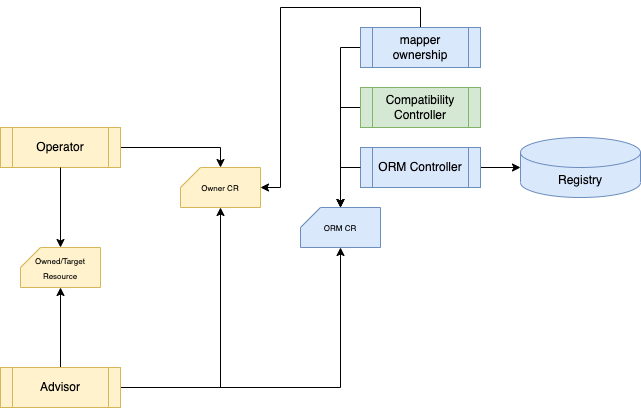Previous ORM CRD and Samples are moved to archive, please find doc for compatibility here.
Table of Contents generated with DocToc
Operator Resource Mapping (ORM) is a map to allow assets like Kubeturbo to manage resources in an Operator managed Kubernetes cluster, for example to vertically scale containers or horizontally scale pods.
ORM works at operand basis, user defines which operand holds the desired status of which resources so that other assets can coordinate resource changes.
This repo provides new ORM resource scheme, legacy ORM CRD and examples are in archive folder. Controllers in this repo are
- helping users to compose and test ORMs with the operands and deployed resources only.
- generating ORM resource from legacy ORM resources for backward compatibility
Advisor: Tools providing recommendations to workloads (e.g. Turbonomic, HorizontalPodAutoscaler, VerticalPodAutoScaler). In this phase 1, Advisor can get the mapping from ORM resource and modify the owner for recommendation.
Owner: the operator resource who owns actual deployed resources. Changes in owner trigger operator to update deployed/owned resources
Owned resource: resources deployed by operator, answer to changes in operand/owner
Mapping: pair of paths in owner and owned resources
Pattern: pair of paths in owner and owned resource. Parameters can be defined in patters in order to generate multiple mapping from one pattern.
Selectors: predefined label selectors to be reused in patterns
Parameters: predefined list of strings for mapping generation
Predefined Parameters - all predefined parameters starts with "."
.owned.name: refer to the name of the owned resource. Together with label selector ofownedresource, a pattern can generate lots of mappings if the naming is right.
System architecture is described in the figure below:
ORM Controller – watch ORM resource and update registry with mappings
Mapper Ownership – retrieve value from owner resource and update ORM status
Compatibility Controller - Generate new ORM from legacy ORM
ORM leverages operator sdk to create/build project, follow the standard operator sdk approach to run it locally or generate images to deploy to a target cluster with right RBAC settings.
mkdir turbonomic
cd turbonomic
git clone https://github.com/turbonomic/orm.git
cd orm
You're able to run the orm controllers if you have access to a kubernetes cluster. Please ensure the rbac of your current access is able to cover the resources you want map.
make install runYou terminal is occupied by the controller after it is started, you need to start another terminal to try examples
Feel free to try other approaches in Operator SDK such as OLM deployment, Direct deployment.
In order to show relationship between operator and the resource it manages we use Redis operator from OT_CONTAINER-KIT. We created redis standalone.
helm list -ANAME NAMESPACE REVISION UPDATED STATUS CHART APP VERSION
redis ot-operators 1 2023-05-04 12:27:31.051399 -0400 EDT deployed redis-0.14.2 0.14.0
redis-operator ot-operators 1 2023-03-13 12:31:40.264923 -0400 EDT deployed redis-operator-0.14.3 0.14.0
Apply the redis standalone orm from library and you can see the pattern defined in spec are located in the cluster. Details are showed in status.
kubectl get orm -n ot-operators redis-orm -o yamlapiVersion: devops.turbonomic.io/v1alpha1
kind: OperatorResourceMapping
metadata:
name: redis-orm
namespace: ot-operators
...
spec:
mappings:
patterns:
- owned:
apiVersion: apps/v1
kind: StatefulSet
path: .spec.template.spec.containers[?(@.name=="redis")].resources
selector: my_redis_sts
ownerPath: .spec.kubernetesConfig.resources
selectors:
my_redis_sts:
matchLabels:
app: redis
owner:
apiVersion: redis.redis.opstreelabs.in/v1beta1
kind: Redis
name: redis
status:
lastTransitionTime: "2023-05-04T17:27:05Z"
owner:
apiVersion: redis.redis.opstreelabs.in/v1beta1
kind: Redis
name: redis
namespace: ot-operators
ownerValues:
- owned:
apiVersion: apps/v1
kind: StatefulSet
name: redis
namespace: ot-operators
path: .spec.template.spec.containers[?(@.name=="redis")].resources
ownerPath: .spec.kubernetesConfig.resources
value:
resources: {}
state: okIn the phase 2 of this project, we're introducing more Advice Mapping related controllers to automate changes from community assets. Details are described here

